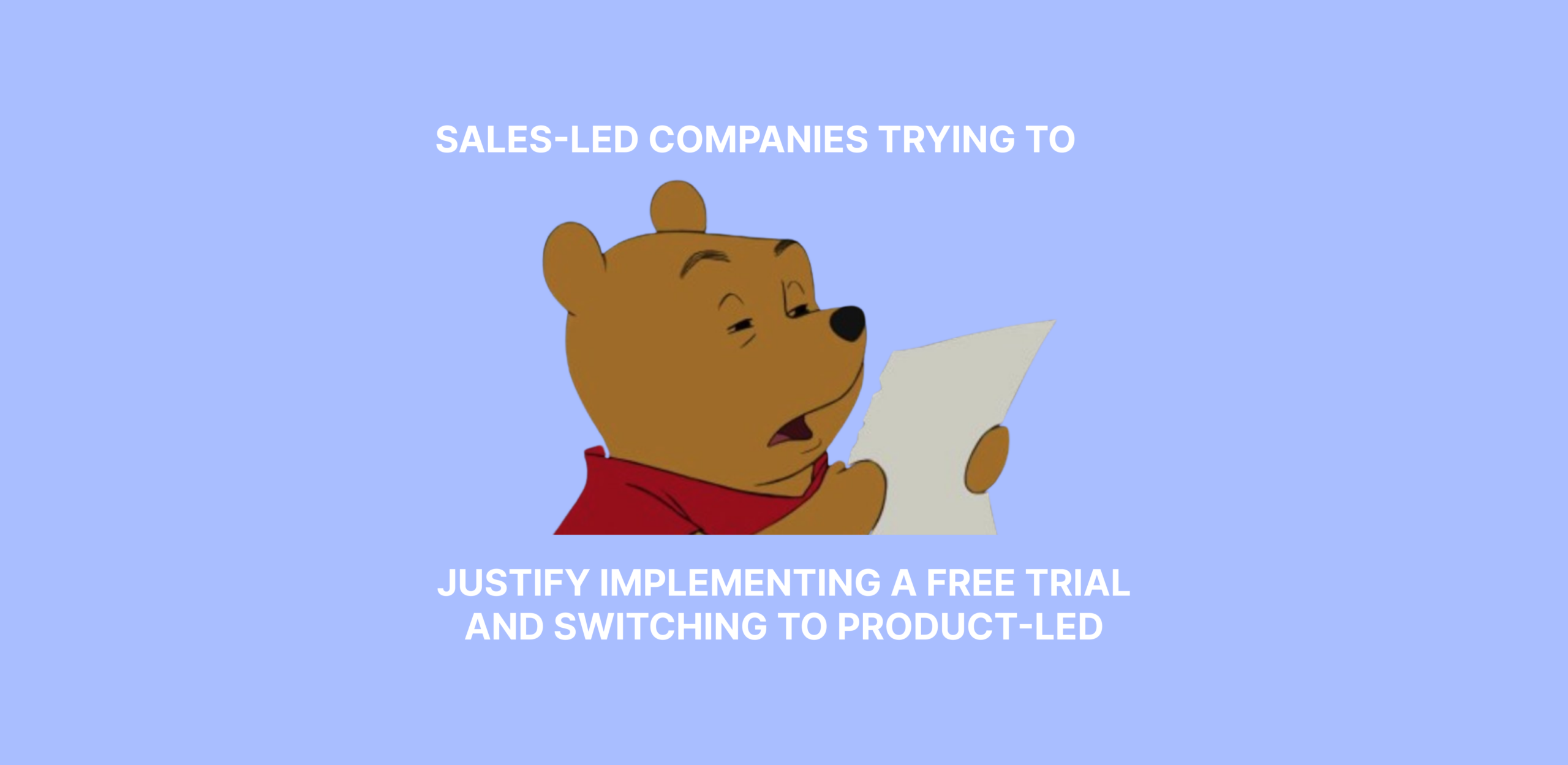Many companies have started to implement product-led growth as their primary go-to-market strategy, and free trials for everything are shaking up the internet.
But making a switch is not as easy as implementing it from zero.
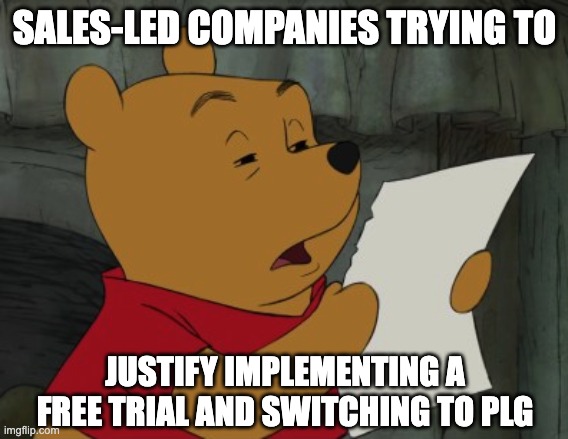
Still, there are too many cases in which product-led growth brought a company from 10 to 100 quickly.
So today, I will be talking about how you can best implement product-led growth strategies into your own business to accelerate your growth and get better results quicker.
TL;DR
PLG is a business methodology where the product is the primary driver for customer acquisition.
The key characteristics of a PLG company are Free user experience, transparent pricing, data-driven, customer-centric, prioritizing PQLs, having self-serve onboarding, and prioritizing inbound marketing.
To execute product-led growth strategy, you should:
- Define your product’s core value,
- Build a user-centric product experience,
- Use data to guide growth,
- And never stop testing and learning.
Also, apart from the main steps, there are a few additional actions you can take that will solidify the base of your strategy. Those steps are:
- Getting all teams on the same page,
- Turning your product into the #1 customer success driver,
- And knowing how to collect and use feedback.
Key Characteristics of a Product-Led Growth Company
What separates PLG companies from the rest?
Let me break it down for you:
- Free User Experience: They offer a free version or trial to give users a firsthand experience of the product’s value. This could be a free trial or a freemium version of your product.
- Transparent Pricing: PLG companies are clear about what their product costs and what benefits come with each price point. This transparency falls over everything, the main pricing, the add-ons, extra services, and limits.
- Data-Driven: They harness data to improve the product, focusing on metrics such as Net Promoter Score (NPS), Customer Acquisition Cost (CAC), and Monthly Active Users (MAU).
- Customer-Centric: Improving the product based on user feedback and needs is a priority. Of course, you won’t just do everything your customers ask for. However conducting surveys and analyzing data to see what you need to add or improve is a must in PLG.
- Prioritize Product Qualified Leads (PQLs): PQLs, users who have experienced the product’s value, are valued over other leads. You can still collect MQLs or SQLs, but make sure to put the majority of your effort toward PQLs.
- Self-Serve Onboarding: With an intuitive product and user-friendly self-serve onboarding, customers can start benefiting without extensive hand-holding. This will both make it easier for the customer and lower the workload of your support team.
- Inbound Marketing: In PLG, the power of word-of-mouth and organic discovery fuels growth rather than cold outreaches and email lists.
Step-by-Step Guide to Implementing Product-Led Growth
1. Define Your Product’s Core Value
Without knowing and passing your core value to the end user, sorry to say that, but you are far away from implementing product-led growth in your company.
Your product’s core value is the unique benefit that makes it a must-have for customers.
Identify it, articulate it, and make sure it shines through in every user interaction.
But how?
Identify it by analyzing customer actions. What is the point they decide to convert? Ask them questions. Why do they love your product?
If you have competitors, see their reviews. Why do people like their services? This can give you an idea about what people are looking for in products like yours. Or if you had beta testers, ask them what was the easiest and the most difficult thing about your product for them.
Articulate it on your website, on your blog, within the product, and during the onboarding. Tell your customer what makes your product “the one” and don’t wait for them to figure it out.
And make sure it shines through in every user interaction by congratulating your users.
Just like CrazyEgg did in the example below.
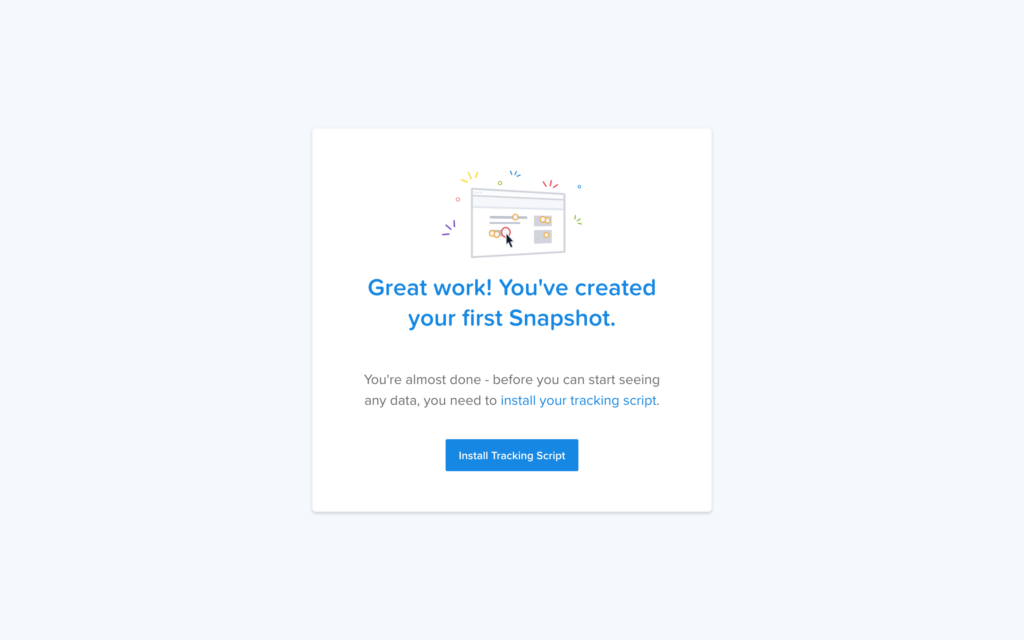
2. Build a User-Centric Product Experience
Design your product with the user in mind – obviously.
After all, you are the one creating the product for them.

- Make onboarding easy. Don’t expect the sales representative to show them a demo on a call only once, and expect the users to grasp it. Have a self-serve onboarding source available within the product. This can be a video, or even better, an interactive onboarding guide.
- Make the interface intuitive. There is a reason why Google keeps removing buttons from the main search page. For instance, they removed even the “I’m feeling lucky” button. All that happened for the sake of simplicity. So the moral of this story is, keep your UI simple, and your UX easy.
- And make user satisfaction your ultimate goal.
Remember, your users should be able to derive value from your product with minimal assistance from the support team.
3. Keep Your Pricing Transparent
I already mentioned transparent pricing as one of the key characteristics of a PLG company. Still, it is also a step to implement product-led growth.
Being user-centric doesn’t end with your product, you should also apply it to your web page, and your marketing strategies.
And allowing them to see your pricing bright and clear on your website builds trust, and speeds up the process.
You probably have heard of HubSpot before as a perfect example of product-led growth. Having said that, this is what one of the best PLG company’s pricing pages looks like:
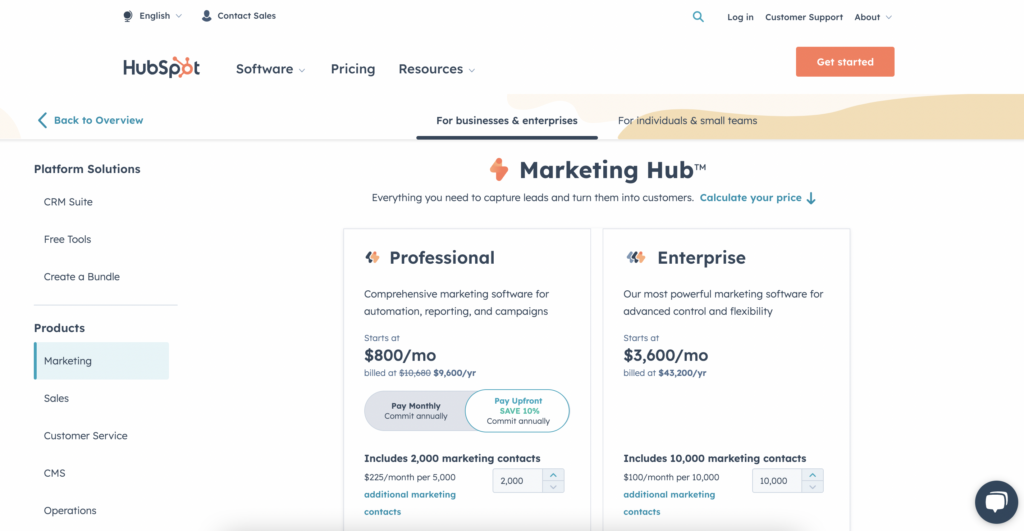
Do you see anything hidden?
Me neither.
Let’s get to the next part.
4. Use Data to Guide Growth Strategies
Let data be your compass for faster growth.
Track key metrics such as:
- NPS (Net Promoter Score),
- CAC (Customer Acquisition Cost),
- MAU (Monthly Active Users),
- And your own metrics that vary depending on your product’s needs.
Let these insights and the data you collect guide your growth strategies. Remember, the specific metrics you track might vary based on your business model and goals.
So how do you collect this data?
With analytics tools. Don’t worry, most of them are free to use. For instance, Google Analytics can be a good starting point since it is 100% free to use and has plenty to offer.
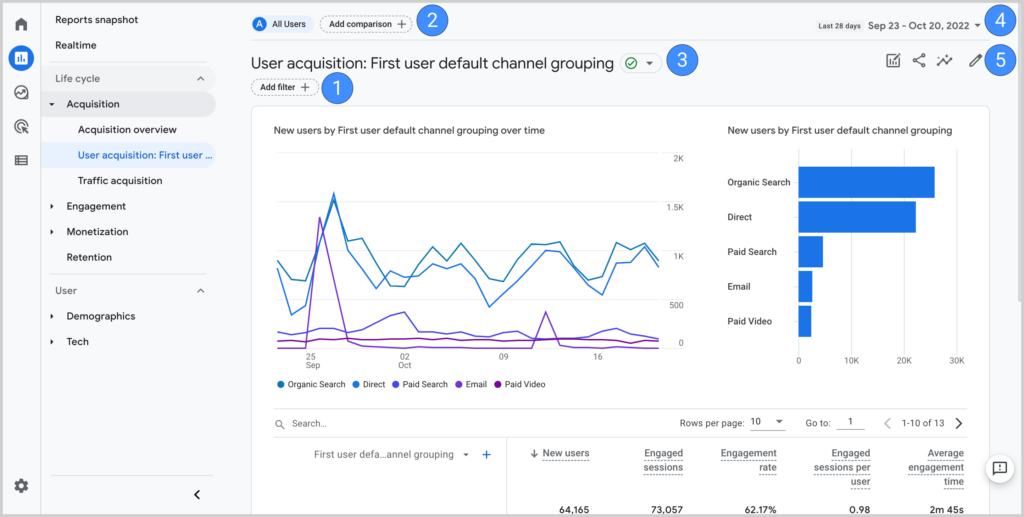
5. Onboarding is Leading
So, I have already mentioned that you need to have a part of your product available for free for the users to explore. But do you just give it to them and let them figure the rest out?
Definitely not.
You need to have a spectacular onboarding sequence to truly bind all trial users to the product. And as weird as it sounds, having a “spectacular onboarding” isn’t difficult.
I say skip the long reads and manuals, and implement one of the two methods below:
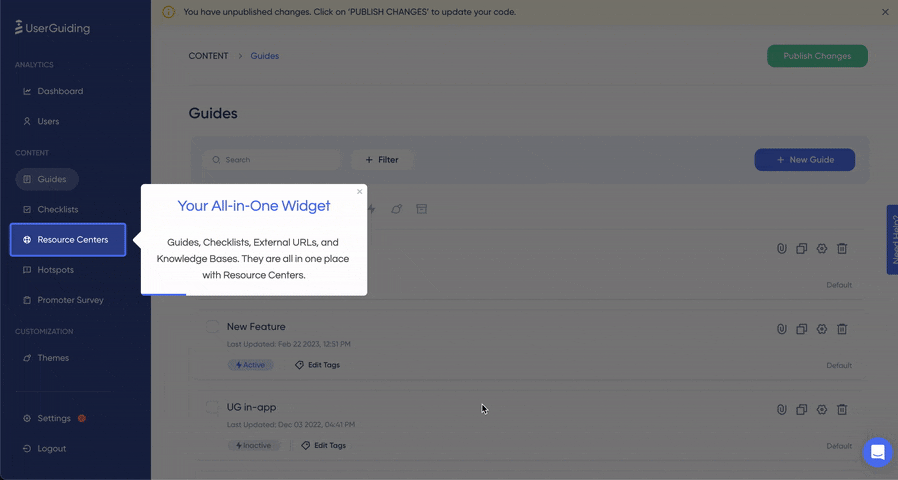
- Interactive Onboarding:
If you have ever played a game, then you know what interactive onboarding is. Instead of having to digest the whole process at once, you give your users the liberty of getting on board at their own pace, step-by-step.
UserGuiding is a great tool if you would like to implement a 3rd party tool and skip the development time, or Intro.js is a good open-source library if you have the time and a spare developer. - Video Onboarding:
This is a more traditional approach to user onboarding, and it is basically a single modal that welcomes the first-time user and shows them how the tool works on video.
6. Continue Testing, Learning, and Iteration
The best thing about PLG is that it keeps developing each and every day. But this is also the most difficult aspect of it.
And it is not only PLG but also the expectations of your users that keep changing. And that’s because their needs change too.
That’s why you have to adopt a cycle of continuous testing and iteration to keep up-to-date with all the expectations and changes that are occurring.
If you feel the need, don’t be afraid to start from the beginning. Go back to step one every once in a while and see if your users still love your product for the same reasons, or if their expectations are still the same.
Essential Actions for Optimal Product-Led Growth Results
So, if you have implemented a strategy but left it there, you probably could guess that you can’t get the most out of it.
Think of it as making a cake. It doesn’t finish when you bake the perfect cake, you also have to decorate it. Some more, some less, but definitely all of them
Here are three of the most important decorations for the PLG cake:
Fostering Internal Alignment on PLG Approach
Everyone in your organization should understand and be on board with the PLG approach.
From sales to customer support, everyone should be aligned with the goal of driving growth through product value.
In order to make sure all your teams are aligned, you can always use a project management tool.
Notion, Clickup, and Jira are my personal favorites. Honestly, I use Notion as a notepad and collective resource center, and Jira as a time tracker and planner.
It took me a few tools to realize this combination works best for my team, so, feel free to try other tools you know too.
And also, if you work remotely, have weekly team meetings and monthly company meetings where you bring everyone on the same page.
You can also use these meetings as a morale booster, and encourage the team to use the project management tools.
So what changed when my team found the right fit?
We started generating faster results since we were now all on the same page.
So during times of remote working and extreme reliance on tools, using another tool for internal alignment is key.
Ensuring Customer Success with Your Product
The key to implementing product-led growth is delivering value through your product. I’m not telling you to dismiss your customer success team or stop using additional tools.
But, the product itself should be at the top.
Give out promotions if you want, host workshops and webinars if you want, and create the best help center ever if you want. But still, make sure that your product sits on top of those all.
Hence, ensure your customers succeed in achieving their goals with your product.
Leveraging Customer Feedback for Continuous Improvement
Customer feedback is your goldmine for product improvement.
And the best thing about feedback is that you don’t have to analyze it to understand it. The feedback giver already summarizes their thoughts and expectations for you.
So why not collect feedback within your product and make it a part of the experience for your users, just like Tumblr?

Conclusion: Setting Your Company on a Path to Product-Led Growth
Adopting a Product-Led Growth strategy is much like embarking on an adventurous journey where the product wears the crown, data charts the course, and the customer heartily enjoys the ride.
This approach emphasizes continual learning, adaptability, and a relentless focus on user needs. To embark on this journey, one must foster a culture of transparency, robust data-driven decision-making, and constant iteration based on invaluable customer feedback.
All these principles, once adopted, can set your company firmly on the path to embracing Product-Led Growth, with the promise of sustainable success and customer satisfaction in this product-centric era.
FAQs
To fully grasp product-led growth and implement it, identify your product’s core value, build a user-centric experience, use data for strategy, foster internal alignment, ensure customer success, and leverage feedback for continuous improvement.
Use data to identify opportunities, continually test and learn from results, iterate your strategies based on these insights, and always keep customer success at the core.
Offering a free product experience, transparent pricing, being data-driven, prioritizing PQLs, having self-serve onboarding, relying on inbound marketing, and constant iteration based on customer feedback are the keys to product-led growth.

